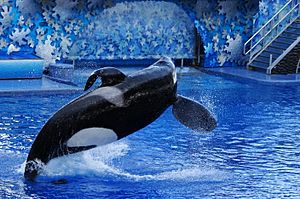Tilikum (orca) facts for kids

Tilikum during a 2009 performance at SeaWorld
|
|
| Species | Orca (Orcinus orca) |
|---|---|
| Breed | Icelandic |
| Sex | Male |
| Born | c. December 1981 |
| Died | January 6, 2017 (aged 35) Orlando, Florida, US |
| Years active | 1983–2016 |
| Known for | Involvement in the deaths of three people |
| Offspring | 21 (9 alive as of July 2021[update]) |
| Weight | 12,500 lb (5,700 kg) |
Tilikum (born around December 1981 – died January 6, 2017), also called Tilly, was a male orca who lived in captivity. He spent most of his life at SeaWorld Orlando in Florida. Tilikum was captured near Iceland in 1983. About a year later, he moved to Sealand of the Pacific in Canada. In 1992, he was transferred to SeaWorld in Orlando, Florida. He became a father to 21 calves during his life.
Tilikum was a main focus in the 2013 documentary Blackfish. This film suggested that orcas living in captivity can suffer and become unusually aggressive. Tilikum was involved in three of the four known incidents where captive orcas caused human deaths. These incidents involved Keltie Byrne, a trainer at Sealand of the Pacific; Daniel P. Dukes, a person who entered SeaWorld Orlando after hours; and SeaWorld trainer Dawn Brancheau.
Contents
About Tilikum
Tilikum was the biggest orca living in captivity. He was about 22.5 feet (6.9 m) (6.8 meters) long. He weighed around 12,500 pounds (5,700 kg) (5,670 kg). His front fins, called pectoral fins, were 7 feet (2.1 m) (2.1 meters) long. His tail, called a fluke, was curled under. His tall dorsal fin, which was about 6.5-foot-tall (2.0 m) (2 meters), was completely bent over to his left side. This is a common condition for orcas in captivity.
His name comes from the Chinook Jargon language. It means "friends, relations, tribe, nation, or common people."
Tilikum's Life Story
Early Life and Capture
Tilikum was captured when he was two years old. This happened in November 1983, near Berufjörður in eastern Iceland. He was caught along with two other young orcas using a large net called a purse-seine net.
After spending almost a year in a tank in Iceland, he moved to Sealand of the Pacific in Canada. At Sealand, he lived with two older female orcas, Haida II and Nootka IV. Orcas in the wild live in family groups led by females. Because of this social structure, Tilikum was sometimes treated aggressively by the two older females. They would force him into a smaller pool. Trainers kept him there for his safety.
Incidents with Humans
It is very rare for orca attacks on humans to happen in the wild. No fatal attacks by wild orcas have ever been recorded. However, as of 2022, four humans have died from interactions with orcas in captivity. Tilikum was involved in three of these incidents.
Returning to Shows
Tilikum started performing again on March 30, 2011. After the incident with trainer Dawn Brancheau, new safety rules were put in place. High-pressure water hoses were used to massage him instead of trainers' hands. Removable guardrails were also used on the platforms. This was because the OSHA limited close contact between orcas and trainers. They also made workplace safety stronger.
Tilikum often performed with his grandson Trua during the One Ocean show. Sometimes, he was also with his daughter Malia, or both Trua and Malia. In December 2011, Tilikum stopped performing for a while because he was sick. He started performing again in April 2012.
Health Decline and Death
In March 2016, SeaWorld announced that Tilikum's health was getting worse. They thought he had a lung infection caused by bacterial pneumonia. By May 2016, reports said Tilikum's health was getting better.
However, on January 6, 2017, SeaWorld announced that Tilikum had died early that morning. The cause of his death was confirmed to be a bacterial infection.
Offspring and Reproduction
Tilikum became a father to 21 calves while in captivity. In November 2013, 11 of his offspring were still alive.
Tilikum had his first calf when he was about eight or nine years old. This happened at Sealand of the Pacific. His first son, Kyuquot, was born to Haida II on December 24, 1991. Just a few months before Kyuquot was born, Tilikum was involved in the first incident that led to a human death. SeaWorld then asked for Tilikum to be moved to their facility right away.
After Tilikum arrived at SeaWorld, he became a father to many calves with different female orcas. His first calf born in Orlando was with Katina. Katina gave birth to Taku on September 9, 1993. Taku died on October 17, 2007.
Some of Tilikum's other calves include: Nyar (born 1993, died 1996), Unna (1996–2015), Sumar (1998–2010), Tuar (1999), Tekoa (2000), Nakai (2001-2022), Kohana (2002-2022), Ikaika (2002), Skyla (2004-2021), Malia (2007), Sakari (2010) and Makaio (2010).
In 1999, Tilikum began training for artificial insemination. This is a way to help animals have babies without direct mating. In early 2000, Kasatka, who lived at SeaWorld San Diego, gave birth to Tilikum's son, Nakai, on September 1, 2001. On May 3, 2002, another female in San Diego, named Takara, had Tilikum's calf through artificial insemination. Tilikum was also the first captive orca to successfully become a grandfather. His grandchildren include Trua (2005), Nalani (2006), Adán (2010) and Victoria (2012–2013).
See also
 In Spanish: Tilikum para niños
In Spanish: Tilikum para niños
- Tilikum v. Sea World
- Incidents at SeaWorld parks
- List of individual cetaceans


